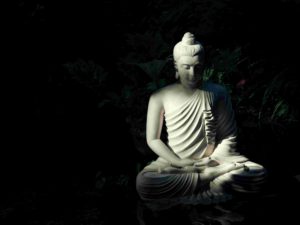I recently had the pleasure of interviewing the incredibly kind, joyful, and wise meditation teacher Spring Washam for the Learn to Love Podcast.
We talked about a lot of things, including Black Lives Matter, how to hold the complexity of the human experience with a fierce heart, and the importance of compassion.
But there was one sentence that Spring said that has been on my mind ever since, because it relates to so much more than just meditation. It was just a short and simple phrase, but its meaning has profound implications for those of us doing spiritual work in the world. She said,
The real path of transformation is taught with a whole lineage behind it.
Indeed. It really got me thinking about some of the many problems with modern yoga and spirituality in general that you see today, because that may be the root of it all: we have lost touch with its history.
This Game of Telephone
Yoga has become an interesting game of telephone over the past few decades. One person learns a concept from somewhere, and it gets repeated so many times that the concept becomes shaped, distorted, and totally divorced form its original meaning and intention.
The first time I went to India to study yoga, I had been practicing the poses for many years, reading tons of books, and had even received a Masters Degree in East-West Psychology. So when our teacher asked, “does anyone know what the term hatha means?” I was confident in the answer.
“Ha means sun and tha means moon, and hatha yoga strives to integrate both the solar and lunar aspects of our experience, uniting our nervous system,” I answered proudly.
My teacher then looked at me blankly, dumbfounded. He then blinked a few times and replied, “No,” before turning to the rest of the class, “Hatha means force. It’s a forceful and intense practice designed to discipline and purify the body.”
Wait, what? Hatha means force? But I had heard this “sun and moon” thing multiple times from multiple people and multiple sources. I was so sure my teacher was flat-out wrong that I went to a Sanskrit dictionary to prove it, but sure enough, hatha meant force, and sun and moon were nowhere to be found.
Unfortunately, this was not the first time I’ve been corrected on something yoga related. This was just one experience of many where concepts, terms, and histories that I had heard from people turned out to be incorrect or entirely made up.
That’s because the real path of transformation is taught with a whole lineage behind it. If there is not a whole lineage behind what someone is teaching, there is no one and no thing to correct them. No scriptures to turn to, no elders or gurus to put them on the correct course.
That Doesn’t Sound Right
For example, take the chakras. Although the term chakra today brings up 7 rainbow-colored centers aligned along a person’s spine, this is a modern interpretation skewed by Western New Age beliefs and occultism.
In reality, there is no consensus on a single chakra system, and there are numerous other systems and conceptualizations of what our “energetic bodies” might be, including entirely different numbers, locations, visualizations, and colors. There is for example the eleven chakra system in 10th century Kaulajnananirnaya text, four chakras in the 10th century Buddhist Hevajratantra, and the nine chakra system in the 18th century Siddha Siddhanta Paddhati. Not to mention the possibilities that the chakras are not wheels at all but perhaps lotuses, knots, seasons, voids, or winds (or that these other forms take precendent).
Unfortunately because one single understanding is oft-repeated, it becomes the only truth. As Ray Baskerville notes:
Unfortunately, much of the information on chakras is simply a repeating of what has been said or written elsewhere and the basis of its authority is only from in their repetition. Very often components from different theories become mixed together adding to the confusion and misunderstanding.
So in teaching anything we have to remember that the real path of transformation is taught with a whole lineage behind it. If there is not a whole lineage behind it, things can go wrong, and they do.
“New Yoga”
Not only do many practitioners ignore yoga’s rich and complex history, but they also take pride in inventing and practicing “new types” of yoga, such Anusara, Bikram, Kripalu, or Jivamukti yoga. Unfortunately, the type of people that think they are inventing new types of yoga tend to have a strong overlap as those prone to perpetuating abuse, megalomania, and cultish tendencies, as in the case of Anusara , Bikram, Kripalu, or Jivamukti yoga.
Rarely, if ever, are new types of yoga like Rocket, Shadow, and Forrest yoga new at all, but merely a rehashing of common yoga poses and mantras into a singular franchise or brand. Yoga is a billion dollar industry now, and in the capitalistic United States, you must “differentiate” your business from others, and creating a new name and brand is an all-too common way to do it.
But when you claim your “brand” of yoga is new, it divorces the practice of yoga from its roots, and it loses so much in the process. While fasting can be a deeply spiritual practice, it turns into a weight-loss solution. While asana is meant to discipline the body for stillness meditation, it’s being integrated into High Intensity Interval Training for six-pack abs.
Remember: practitioners are supposed to dissolve their egos, not inflate them.
How did yoga become so distorted? Because the real path of transformation is taught with a whole lineage behind it. If there is not a whole lineage behind it, we often lose what is most essential about the teachings.
McMindfulness
We see this same phenomenon today in the world of mindfulness meditation. Mindfulness is the hottest fad nowadays, with thousands of research articles, smartphone apps, books, and other media espousing its benefits.
But mindfulness comes from the Buddhist tradition, and when you take it out of its spiritual context, you lose so much. Mindfulness is just one step of the eight-fold path, which needs to be practiced along with right livelihood and right conduct.
And it’s not just mindfulness either, it’s right mindfulness, meaning practicing mindfulness in the right way. The right way is with love and a recognition of our interconnectedness with all things. The way we teach mindfulness meditation nowadays is like giving someone flour and saying its a cake.
Without kindness, its not right. Without kindness, you have the Congressman Tim Ryan wanting to teach mindfulness to our military, rather than stop promoting violence and imperialism around the world. Mindfulness is being taught to CEOs of corporations that are destroying the planet and police officers who then go to arrest and abuse people of color. You can mindfully kill someone, believe it or not.
When spirituality is reduced, commodified and packaged for a larger, Western audience, it loses its impact. It loses its power of transformation and only keeps us stuck in our suffering.
Remember Where You Came From
So what is the solution? It’s right in front of us: go back to the roots. Study the sacred texts. Not just Pantajali’s Yoga Sutras, but the Upanishads, Bhagavad Gita, DhammaPada, and Tao Te Ching. Learn from authentic teachers who have done the true emotional work, praise the past gurus that have passed along these teachings.
Our spiritual practice means going deep. We are not here to dig 6 foot wells in search for water. We are here to stick with a practice, teaching, lineage, and tradition, and go as far as it can take us, even though it may be hard.
Because the real path of transformation is taught with a whole lineage behind it.










2 thoughts on “Has Yoga Lost Its Roots?”
Pingback: The Second Wing of Our Spiritual Awakening - Zach Beach
Pingback: The Six Paths to Spiritual Wisdom - Zach Beach